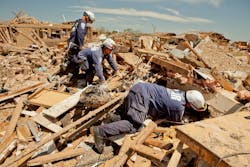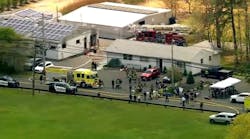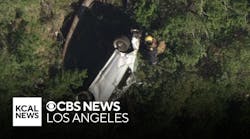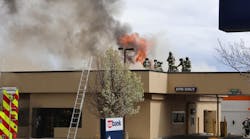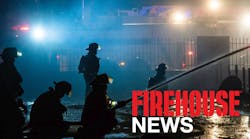Nationally, the availability and operational capability of Urban Search and Rescue (USAR) rests upon 28 federally sponsored resources and numerous state USAR resources provided through governmental, private, and non-governmental organizations. These resources are “systems and capabilities,” so critical to the United States that the incapacitation of, or inability of such resources to deploy has a debilitating effort on national and state response and recovery operations, public health and safety, or any combination of life-, health-, and safety-related priorities throughout disasters.
The need for a catalog of national USAR resources was realized as an after-action item from the national level exercise of the New Madrid Earthquake Scenario. Government officials have a need to understand what resources, including USAR, are available to potentially assist during a disaster. It is critical for state and local officials to understand the various kinds and types of resources available to them when requesting mutual aid resources. That ensures the proper resources are ordered and with the developing catalog, governors and mayors ensure their requests are being met with the correct assets.
Reports show need for national catalog
The Post-Katrina Emergency Management Reform Act of 2006 (PKEMRA) requires that states receiving federal preparedness assistance administered by FEMA will report on their levels of preparedness and that an assessment of current capabilities are established. Importantly, in the 2012 National Preparedness Report (NPR), a key finding concludes: "The Nation has a highly mature structural collapse search and rescue capability, due in large part to the build-up of state and local search and rescue assets." Significantly, the 2013 National Preparedness Report recognizes that “The 2012 NPR highlighted the nation’s mature capabilities in structural collapse search and rescue (SAR) efforts…A mass search and rescue event, such as a catastrophic earthquake would require a surge in SAR resources beyond traditionally available sources.”
Organizationally, USAR represents capabilities that are not fully maximized during disaster, nor adequately recognized as "available" assets prior to impact from natural, technological, or human-caused events. Individual USAR capabilities of non-federal resources are not fully understood, or accepted, and suffer from policy, logistical and socio-perceptive isolation. To truly determine the nation’s USAR capability, a common assessment framework and methodology based on national standards must be established for the USAR infrastructure that considers and accepts individuality found within the whole community.
The establishment of national standards for USAR teams and the assessment of tiered-response assets is critical to the reporting of national preparedness along with the criticality of ensuring that the right USAR resource is getting to the scene of a disaster in a timely manner. USAR resources and tiered-response assets against a set of American National Standards Institute (ANSI) certified national standards for emergency preparedness and response would ensure that happens.
Standards development and EMAP certification process
To that end, the goal of achieving a truly nationally certified USAR system, recognized by all participants and communities in need, was spearheaded by many partners including the federal government, State Urban Search and Rescue Alliance and Emergency Management Accreditation Program (EMAP). Over a series of working group meetings including representation from the National Preparedness Assessment Division (NPAD), FEMA's USAR Program Office, National Integration Center (NIC), federally sponsored USAR team members, State Urban Search and Rescue Alliance (SUSAR), the Emergency Management Assistance Compact (EMAC) and EMAP, the "Urban Search and Rescue Standard," was drafted, submitted and accepted by the ANSI as an American National Standard (ANS).
EMAP, as a recognized third-party standard development organization, coordinated the effort to write the "Urban Search and Rescue Standard" along with providing peer-review assessments to validate USAR teams. The standard is scalable, modular, and consistent as written and reviewed by the whole community. The standard delivers a consistent set of criteria enabling USAR resources the opportunity for enhancement and improvement. Nationally, the standard has and does provide a defined set of processes for USAR resources to seek recognition through the EMAP certification program. Recognition for both hard work and dedication to the profession; having met established and accepted national criteria; and completing a self-assessment and independent peer assessment resulting in certification.
Administrative criteria established through the "Urban Search and Rescue Standard" and assessment processes established for task force teams provides the consistency necessary for independent third-party certification. The standard covers administrative functions of any type of team from:
- Program management
- Finance
- Planning and procedures
- Alert and mobilization
- Training and exercises
- Resource management and logistics
The standard is designed as a tool for continuous improvement and establishes criteria for the administration, operational, and logistics readiness of teams within a discipline. The standard is used as the backbone of third-party assessments of activities of the USAR teams.
Meeting benchmarks
USAR Resources have a legitimate need for an independent, unbiased assessment of their activities. In spite of the best intentions, deviations from expected procedures may occur in teams, however, the accountability of assessments ensures that management is benchmarked against the standard.
Assessments assist in providing a gap analysis of deficiencies that can be managed strategically prior to a disaster response. Through third-party assessments individuals are held accountable for failing to anticipate failures in their system or are held accountable for the design of the organization, both retrospectively and prospectively.
Certification and integration into mutual aid systems such as EMAC establish a common goal: deployment of the correct resource, in the shortest time possible, to bring capabilities to the disaster scene. This certification can now be cataloged in an organization like EMAC providing a clearinghouse of validated and certified resources capable of providing resources to state and local governments in times of crisis. With a catalog of nationally EMAP-certified USAR resources, communities will be able to ensure that resources coming to bear during a disaster will be capable of assisting in the response operations and helping to locate and care for survivors.
Certification of USAR Resources doesn’t only provide recognition as a final outcome; rather, established a national system for recognition and capability that is required not only during disaster, but on a daily basis in our communities. The incentive for a USAR team to undertake the certification process would be the validation and inclusion in a national system.
TODD LIVINGSTON is a captain with St. Petersburg, FL, Fire & Rescue and is a task force leader for Florida USAR Task Force 3. He is the chairman of the Florida Association of Search and Rescue and vice president of the State Urban Search and Rescue Alliance.
